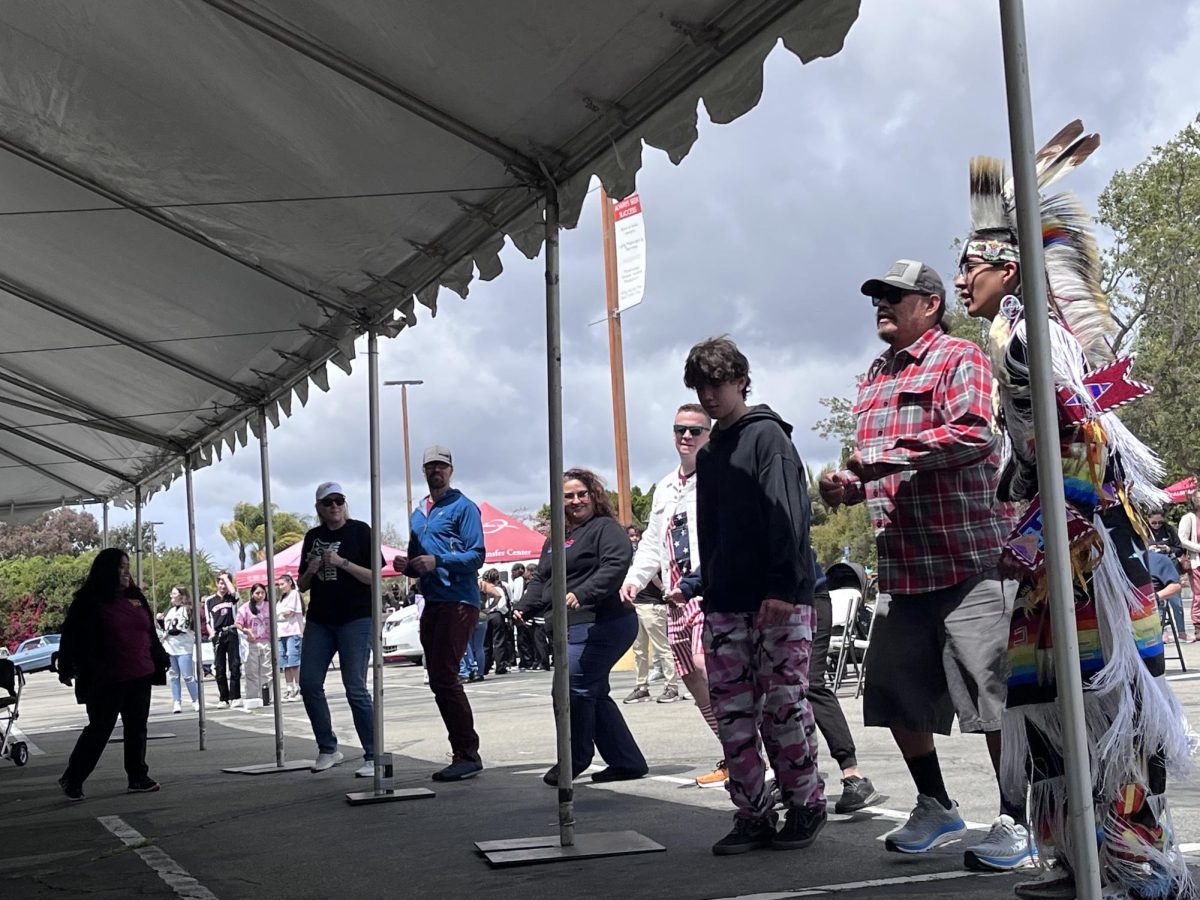In this interview, Bowman states that competitive autocracies work by threatening investigations while coercing preemptive compliance on media companies and other companies in general. In addition, an attempt is made to stack the courts and the legislature in these types of autocracies.
Peter Bowman has worked as a political science professor at Palomar for 21 years, and he’s taught as a community college professor for a total of 29 years. While in graduate school, he specialized in international relations theory and the Middle East. At Palomar, his classes focus on American politics on a local and national level, international relations, and political theory.
Citing polarization, mistrust, disinformation and conspiratorial ideas pervading America right now, Bowman describes in detail the current conditions in the United States that make America’s present slide to autocracy acutely alarming.
The Telescope: Does the United States appear, at present, to be backsliding from democracy to autocracy? And if so, what are the signs?
Bowman: Yes. We’re seeing it in real time, democratic backsliding now.
In my view, and the view of many political scientists and scholars and historians who study autocracy and backsliding, as of now, at least, I see it as quite unlikely that we become the extreme totalitarian cases that many people are fearing… I don’t see us becoming that.
I see it as very possible — and right now we’re on that trajectory — of becoming an illiberal autocracy, aka competitive autocracy.
So, two very important tenets of the First Amendment, free speech and a free press, are being practiced by us right now here at Palomar College. And [with] this speech and expression, there’s been many protests. There have been many pro-immigration and anti-Trump protests, but not to the level of eight years ago.
But nevertheless, protests are still happening. We saw Democratic members of Congress protest Trump’s address to Congress. And so, there’s still a lot of the aspects of a full-fledged, consolidated democracy, or liberal democracy, still in play.
So, we’re still seeing a robust kind of free expression. The Democrats are still one of the two major parties, and so in a competitive autocracy, a lot of the elements of a democracy still take place, but it’s the gradual hollowing from within.
What happens with illiberalism is that the leaders are elected democratically, and the elections are open, free and fair. The 2024 election was a free and fair election. Trump legitimately won fair and square.
This kind of competitive authoritarianism or autocracy begins with, ironically, a free and fair, full-fledged democratic election.
Once the democratically elected leader takes power, then the regime starts to hollow out from within. That’s when you’re again seeing the hollowing out of the executive branch, the hollowing out, or deconstruction, as it’s been referred to, of the administrative state of the executive bureaucracy. Basically, putting a chill on media companies, threatening investigations, and forcing and coercing preemptive compliance on media companies and other companies in general.
It’s common in illiberal autocracies for the chief executive to stack the courts. So far, that has not been fully consolidated. There are over 260 federal judges appointed by President Biden, and another close to that number, 200 some plus appointed by President Obama. And there are a handful of other Republican appointed federal judges from presidents Reagan and Bush, both Bushes that also have been following the rule of law and limiting and trying to rule against the Trump administration.
So right now, the judiciary has not been completely consolidated and taken over by the executive. But over time, gradually, over time, the president will stack the courts – over time, where the courts will then make rulings to fit the president’s narrative.
These are not necessarily independent rulings based on the Constitution, for example, but rather tailoring.
They’re tailored to the president’s rulings. That’s the ultimate goal in stacking the courts. You’ve got one-third of the current US Supreme Court appointed by Trump during his first term. Two-thirds of the Supreme Court are conservatives, and three to four of the Supreme Court justices seem to be sympathetic to this unitary actor theory. And I think it is the goal of the Trump administration to have the Supreme Court rule in favor of Trump based on this unitary actor model. It is so trying.
So, whether it be to uphold his executive order ending birthright citizenship despite the 14th Amendment or allowing the president to do what he wants with the executive branch, including shutting down services, shutting down personnel funding. The Trump administration is hoping that the Supreme Court will rule favorably, legitimizing his power grab, and legitimizing his consolidation of power. And right now, I would not go to Vegas to bet money on either scenario.
I could easily see the Supreme Court, by a five-four ruling, shutting down the Trump administration. And I can see the Supreme Court, by a five-four or six-three ruling, upholding the administration’s policies. But the goal, the hope for the Trump administration, is that the Supreme Court will uphold all of his policies, legitimizing them, and therefore, Trump will have largely completed his goal of stacking the courts.
Another tenet of competitive authoritarianism or illiberalism is stacking the legislature.
You’ve got a Republican Congress in the House and Senate that are largely, with very few exceptions in the Senate, largely compliant and largely supportive of what Trump is doing. A contingent of the Republicans in Congress are true believers. They are true MAGA and they love what he’s doing.
There are other Republicans who are privately alarmed or concerned. Whether it be his support for Russia’s invasion of Ukraine, or whether it be the accelerating … what [the Department of Government Efficiency (DOGE)] is doing, there are Republicans from red districts who are seeing a lot of infrastructure money and a lot of Inflation Reduction Act money benefits their districts.
Republicans have been fielding hostility at town halls. These Republicans probably want to speak out, but they fear Trump or Musk endorsing and financing a primary challenge, according to anecdotal reports.
There are Republican members of Congress that have not just political, electoral concerns at angering Trump and Trump’s voter base, which is also their voter base too. But also, they’re [concerned about the] physical, literal safety for themselves and their family of receiving death threats from Trump’s MAGA base of supporters.
So, through all these reasons of basically, again, compliance, if not full-fledged support.
The Republican Congress has become very compliant, and so Trump has effectively stacked the legislature with Trump loyalists; with MAGA loyalists, or at the very least Republicans who are both politically and safety-wise concerned to speak out.
So, if you have the legislature consolidated under your control, the judiciary consolidated under your control — stacking the legislature, stacking the judiciary in other words — having a chilling effect on the media and private companies, that is effectively illiberalism. And Democrats will still be able to compete again.
There can still be people like you and me who are just the average person who is not particularly powerful or influential, can continue to criticize Trump on social media or just in everyday interactions. but it’s not going to be very efficacious in terms of any kind of political recourse, and Democrats will still be able to compete for elections.
They’ll be able to campaign, but maybe state-level officials in red states, secretaries of state, attorneys general or county-level election certifiers in various states might refuse to certify election results if the election is won by a Democrat. And so that could be how elections can be effectively stymied, and elections can be effectively co-opted by the regime. Again, the idea of modern-day autocracy is not your father’s autocracy.
This is not your father’s Hitler, Stalin, or old-school 20th-century autocracy, where there’s no elections and a complete crackdown on any kind of dissent. Or, in other words, a complete direct crackdown by the state itself.
We’re seeing indirect crackdowns on dissent, intimidation, investigations — again, getting voluntary preemptive compliance, right? Not the state itself directly using its power, but indirectly stacking the court, stacking the legislature, making sure elections appear to be competitive.
But at the end of the day, the ruling party will always continue to win, and the opposition parties can exist. They can campaign, but ultimately, they will not win the elections, and the party in power remains the party in power for an indefinite period of time.
Having said all that, with this fog of uncerntatiy, you really can’t eliminate the possibility of an even further accelerated consolidated autocracy, because of the Trump administration hoping the Supreme Court rules with the administration. If the Supreme Court were to rule against the Trump administration — certainly or especially on a policy that is particularly important to the President on immigration, or again, the executive branch reorganization, or birthright citizenship — the fear, of course, is that, quite simply, the Trump administration will simply not abide by the ruling or will ignore it altogether. In “Federalist 78,” Alexander Hamilton wrote that of the three co-equal branches of government, the judiciary is arguably the weakest. Because, to paraphrase Hamilton, the judiciary has neither the pen nor the sword.
Congress has the pen in terms of writing legislation, and the executive branch has the sword in terms of enforcement, and for the 236 years of our Constitution, it’s the Constitution and its institutions have largely stood up. But despite a lot of imperfections, it’s largely stood up because at the end of the day, the individuals holding stewardship of these institutions have abided by the constitutional norms of compliance with the law or taking care of the law — Article Two, the President’s taking care of the law — and they’ve abided by these norms.
Should the Supreme Court, or any other court — federal, lower, or lower-level federal court — rule against the Trump administration, particularly on a policy particularly important to the administration, and if they decided to ignore the ruling, the U.S. Marshals would have to enforce that ruling. The U.S. Marshals would have to be empowered or directed to enforce the ruling by the Department of Justice — a Department of Justice that’s been politicized and co-opted by Trump and his attorney general.
So basically, the executive branch could refuse to enforce a court ruling fast.
We would have a full-blown constitutional crisis with the Trump administration ignoring court rulings, with no enforcement mechanism coming from the executive branch. That would effectively accelerate from illiberalism into an even deeper kind, a more stark kind of autocracy.
Now we have seen democratic backsliding in many countries, but most of them, or all of them, are relatively young democracies.
We’ve seen Hungary descend into democratic backsliding led by Viktor Orbán. In fact, a lot of Project 2025 policy initiatives are in line with a lot of Viktor Orbán’s policies and actions in Hungary. We’ve seen democratic backsliding what we saw a few years ago, at least democratic backsliding in Poland. And of course, Russia was an electoral democracy for a little bit, for a brief moment before Putin began to re-engage in democratic backsliding there.
People talk about how Hitler was elected and Weimar democratic Germany gave way to Nazism and totalitarianism. The Weimar Republic lasted for a little over a decade. So you know, countries that have undergone democratic backsliding from democracy to autocracy have been, for the most part, countries that have been very young democracies where the democracy doesn’t last a long time.
So, it’s easy to do democratic backsliding with younger democracies whose both institutions and democratic cultures are still relatively young and largely untested or largely enduring. The United States backsliding into autocracy, into illiberalism or even worse, that will be truly, truly notable and monumental, because we’re talking about a republic that’s lasted 236 years, and the political science research shows that a full-fledged, consolidated democracy that is such for at least a couple decades, democratic backsliding is highly unlikely, and yet we’re seeing it with the United States now.
You could play contrarian and say, “Yeah, but how?” But for these 236 years, has the U.S. really been a true, full-fledged liberal democracy for all of those, for every one of those 236 years? We had slavery until 1865; women could not vote nationwide until 1920; we saw Jim Crow in segregation in the South up until only 60 years ago.
So, a lot of the criteria that political scientists would use to provide metrics for a fully functioning democracy, many of them were not there in our history, and so we’ve only been really a full-fledged democracy for about 60 years. But again, 60 years, according to the standard of after an X number of years, should be enough to withstand autocracy.
And yet, because of deepening, widening polarization, mistrust of institutions, mistrust of government, mistrust of the media, mistrust of science, of the scientific community, mistrust of the academic community, and this and a lot of misinformation and the rise of echo chambers, both on the left and the right, but more amplified on the right, with Fox News and various right-leaning social media platforms, which so much of this disinformation and conspiratorial ideas. If you add these factors, make the slide towards autocracy acutely alarming.
Continue reading this interview in part two.
The next article in this series will give Bowman’s speculation on the deconstruction of the U.S. administrative state, in which the executive branch may have already consolidated power beyond the point of no return, as DOGE seeks to act fast and break things.
CORRECTIONS – May 12, 2025 – A correction was made on this story. This is the current version of the story.









